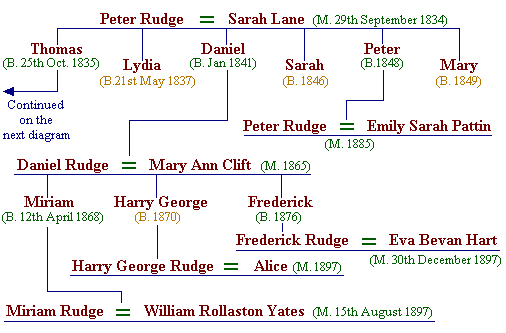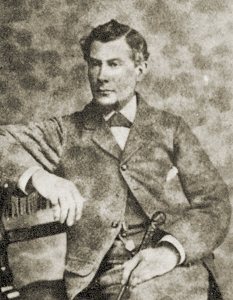The Rudge
Family Talk to anyone about bicycle manufacture in Wolverhampton during the second half of the nineteenth century, and the name Dan Rudge will probably be mentioned. He was a successful cycle manufacturer and produced some of the best racing bikes of the day. Thanks to Marie Cooper, who is a member of the family, and her family research, we are able to include this section on an important Wolverhampton family. We must also thank Derek Beddows who wrote the section on Dan Rudge and his bicycles.
The story starts with Peter Rudge, who married Sarah Lane at Tipton Parish Church, on 29th September 1834. The 1841 census lists the family as living in Wharf Street, Wolverhampton. They had six children:
In the 1851 census, we find that Peter Rudge was a master roll turner, employing three men and a boy. The boy may have been his son Daniel as he is listed as having the same occupation. Peter senior died on 25th October 1859, without leaving a will, and the small estate was finally cleared on 2nd November by Administration.
In 1869 Walter Phillips and George Price became interested in the new cycle industry. Price was primarily interested in the business end of cycle manufacture, whereas Phillips was interested in the actual making of cycles. The two realised that to successfully manufacture cycles they would need a skilled engineer to design and sort out any mechanical problems. Daniel Rudge was approached about manufacturing a velocipede designed by Phillips. A deal was struck and Rudge was soon producing cycles in a small workshop located at the rear of the Tiger Inn, with Henry Clarke supplying the wheels. By the end of 1874 Daniel Rudge had manufactured a small number of high bicycles. His first machines were nothing out of the ordinary as they ran on regular plain bearings. Around this time a Frenchman who had met Henry Clarke during his army service called on him riding a French velocipede. Both Daniel Rudge and Henry Clarke were taken on how the French velocipede ran with ease. They determined to find out the mechanical advantage of the French machine. It is said that that they got the Frenchman drunk. Then dismantled his machine to find that it ran on ball bearings instead of the more traditional plain bearings common on the cycles of the day. By 1878 Rudge had established as a manufacturer of High quality bicycles. Never satisfied with other makers’ designs and construction Rudge invented numerous innovations. In 1878 Rudge took out British Patent No 526 for his adjustable ball bearings. These bearings were fitted to his high bicycles and improved their efficiency. Rudge cycles soon gained a reputation for fast starts and thus became extremely popular. Rudge machines were often handicapped 20 or 30yards behind other racers. Because of this publicity the demand for Rudge cycles increased. Daniel Rudge visited the famous French cyclist Terront in his London hotel while on a visit to England. Rudge proceeded to demonstrate to Terront a set of his patent adjustable ball bearings. Terront was impressed enough to purchase a racing machine built by Rudge. Daniel Rudge also travelled to Paris and Lyons to observe the French cycling scene and to take part in some of the races. The added company responsibility, the company now based in nearby Bishop Street employed 100 employees by 1878 and various other cycle activities had a detrimental effect on Rudge’s health In the early summer of 1880 Daniel Rudge fell ill for the last time. He died at a hospital for the terminally ill at 1 Cumberland Terrace, Ealing, London on 26th June 1880 of cancer at the age of 39. The sales of Rudge cycles remained excellent for several months after his death, but with nobody to run the company the company seemed doomed. Rudge’s widow Mary with the assistance of Walter Phillips arranged the sale of the Rudge cycle concern to George Woodcock of Coventry. The sale arrangement included a cash sum plus a regular pension for Mary Rudge. In exchange Woodcock acquired the famous adjustable ball bearing patent 526 and the services of some of Rudge’s former employees. Woodcock took the cycle company and merged it with The Tangent & Coventry Tricycle Company and formed D. Rudge & Co based in Coventry. D.W. Beddows
Mary was the sole executrix to whom Administration was granted. In 1881 the family was living at 161 Great Brickkiln Street, Wolverhampton. Mary died on 3rd December 1884.
In the 1891 census, we find that the three children were living at 111 Clifton Street. Miriam was described as head of the household, and her brothers as cycle fitters. Miriam married William Rollaston Yates at St. Mark's Church, on 15th August 1897. Harry married Alice in the same year and Frederick married Eva Bevan Hart, also at St. Mark's on 30th December 1897. Eva's father, William Edward Hart was also a cycle maker.
Returning to Thomas Rudge, who was born in 1835. He married Alice Davies Fisher, at St. George's Church on 12th July 1858. They had four children:
Thomas's wife, Alice, died, and the family went to live with Thomas's mother, Sarah Rudge. Thomas later married Eliza Fisher. Frederick James Rudge, married Clara Louisa Pattin in 1889. In 1891 they sailed to Wellington, New Zealand, on the steam ship Ruapehu. They had two children:
After Alice's death, Thomas married Eliza Fisher at Christ Church, Cheltenham, on 5th September 1872. They had four children:
Minnie died on 2nd June 1910. Eliza died on 20th February 1904, and Thomas died on 6th November 1905. Peter Rudge, who was born in 1848, stayed with his mother Sarah, until her death. In 1885 he married Emily Sarah Pattin, the sister of Clara Louisa Pattin. Marie says that she still has a lot of research to do, to fill in the gaps in her family history. If anyone has any information about the family, or can add to what's here, please email her at: |








